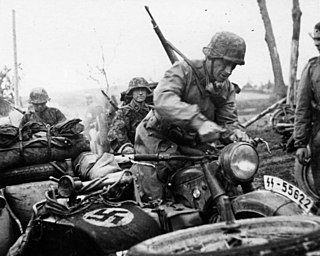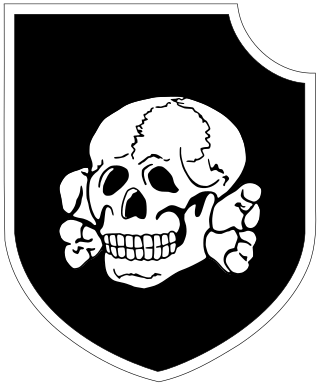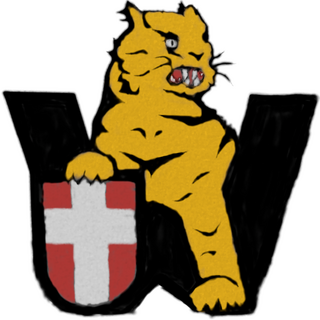
The Waffen-SS was the combat branch of the Nazi Party's paramilitary Schutzstaffel (SS) organisation. Its formations included men from Nazi Germany, along with volunteers and conscripts from both occupied and unoccupied lands. It was disbanded in May 1945.

Michael Wittmann was a German Waffen-SS tank commander during the Second World War. He is known for his ambush of elements of the British 7th Armored Division during the Battle of Villers-Bocage on 13 June 1944. While in command of a Tiger I tank, Wittmann allegedly destroyed up to 14 tanks, 15 personnel carriers and two anti-tank guns within 15 minutes before the loss of his own tank. The news was disseminated by Nazi propaganda and added to Wittmann's reputation.

The Tiger II was a German heavy tank of the Second World War. The final official German designation was Panzerkampfwagen Tiger Ausf. B, often shortened to Tiger B. The ordnance inventory designation was Sd.Kfz. 182.. It was also known informally as the Königstiger. Contemporaneous Allied soldiers usually called it the King Tiger or Royal Tiger.

The 1st SS Panzer Division Leibstandarte SS Adolf Hitler or SS Division Leibstandarte, abbreviated as LSSAH, began as Adolf Hitler's personal bodyguard unit, responsible for guarding the Führer's person, offices, and residences. Initially the size of a regiment, the LSSAH eventually grew into an elite division-sized unit during World War II.
101st Heavy SS Panzer Battalion was a German heavy tank battalion in the Waffen-SS during World War II. With the introduction of new Tiger II tanks in late 1944, the unit was renumbered as the 501st Heavy SS Panzer Battalion.

The 3rd SS Panzer Division "Totenkopf" was an elite division of the Waffen-SS of Nazi Germany during World War II, formed from the Standarten of the SS-TV. Its name, Totenkopf, is German for "death's head" – the skull and crossbones symbol – and it is thus sometimes referred to as the Death's Head Division.

The Flemish Legion was a collaborationist military formation recruited among Dutch-speaking volunteers from German-occupied Belgium, notably from Flanders, during World War II. It was formed in the aftermath of the German invasion of the Soviet Union and fought on the Eastern Front in the Waffen SS alongside similar formations from other parts of German-occupied Western Europe.

The 5th SS Panzer Division Wiking or SS Division Wiking was an infantry and later an armoured division among the thirty-eight Waffen-SS divisions of Nazi Germany. During World War II, the division served on the Eastern Front. It surrendered on 9 May 1945 to the American forces in Austria.

The 9th SS Panzer Division "Hohenstaufen" was a Waffen-SS armoured division of Nazi Germany during World War II. It participated in battles on both the Eastern and Western Fronts. The division was activated in December 1942. Many of the men of the division were young German conscripts, with a cadre of NCOs and staff from the SS Division Leibstandarte and other Waffen SS divisions. Hohenstaufen took part in the relief of German forces in the Kamenets-Podolsky pocket, the Normandy battles, Operation Market Garden, the Ardennes Offensive and Operation Spring Awakening. The division surrendered to the United States Army on 8 May 1945, at Steyr.
The III (Germanic) SS Panzer Corps was a Waffen-SS armoured corps which saw action on the Eastern Front during World War II. The (Germanische) part of its designation was granted as it was composed primarily of foreign volunteer formations.

The 10th SS Panzer Division "Frundsberg" was a German Waffen-SS armoured division during World War II. The division's first battles were in Ukraine in April 1944. Afterwards, the unit was then transferred to the west, where it fought the Allies in France and at Arnhem. The division was moved to Pomerania, then fought south east of Berlin in the Lusatian area until the end of the war.
The 503rd Heavy Panzer Battalion was a German heavy Panzer Abteilung equipped with Tiger I and Panzer III tanks. In 1944, it was re-equipped with the new Tiger II. The battalion saw action on the Eastern and Western Fronts during World War II. As with other German heavy tank battalions, it was normally not assigned to a single corps, but shuffled around according to war circumstances. Later the battalion became part of the newly formed Panzer Corps Feldherrnhalle as the Feldherrnhalle Heavy Tank Battalion.
The 509th Heavy Panzer Battalion was a German heavy Panzer Abteilung, equipped with heavy tanks, during the Second World War.

A German heavy tank battalion was a battalion-sized World War II tank unit of the German Army (1935–1945), equipped with Tiger I, and later Tiger II, heavy tanks. Originally intended to fight on the offensive during breakthrough operations, the German late-war realities required it to be used in a defensive posture by providing heavy fire support and counter-attacking enemy armored breakthroughs, often organised into ad hoc Kampfgruppen.

The 502nd Heavy Panzer Battalion was a German heavy tank battalion during World War II. The battalion was the first unit to receive and field the Tiger I. It fought on the Eastern front. It was one of the most successful German heavy tank battalions, claiming the destruction of 1,400 tanks and 2,000 guns. Otto Carius, one of the best German tank aces, was a member.
The 501st Heavy Panzer Battalion was a German heavy Panzer Abteilung equipped with heavy tanks. The battalion was the second unit to receive and use the Tiger I heavy tank, changing to Tiger IIs in mid-1944.
The 102nd Heavy SS Panzer Battalion was a German heavy tank battalion of the Waffen-SS during World War II. It fought as part of the II SS Panzer Corps during the Battle of Normandy and was nearly destroyed. Renumbered as 502nd Heavy SS Panzer Battalion in late 1944, the unit was destroyed in the Halbe Pocket in Spring 1945.

Heinz von Westernhagen was a SS-Obersturmbannführer in the Waffen-SS during World War II. He was a member of the Leibstandarte SS Adolf Hitler (LSSAH) and commander of the 501st (101st) SS Heavy Panzer Battalion.

The 506th Heavy Panzer Battalion was a german heavy Panzer Abteilung equipped with Tiger I tanks until 28 July 1944. During the period from 20 August to 12 September 1944, it was re-equipped with a full complement of 45 Tiger Ausf. B tanks. Some of the first Tiger IIs delivered to the 506th were examples fitted with the early production turret. The battalion saw action on the Eastern and Western Fronts during World War II. As with other German heavy tank battalions, it was attached as needed to larger formations. The 506th was unique in being the only Tiger battalion to include a fourth company. German: schwere Panzerkompanie Hummel, equipped with Tiger I tanks, was consolidated with the 506th in 1944. It was also unique in that it regularly received new vehicles and replacements from other units to maintain a full complement. The unit served until the collapse of the Ruhr Pocket in April 1945, being officially disbanded by the battalion commander on 14 April. The unit performed well despite often poor conditions of deployment, officially credited with over 400 tank kills during its service with fewer than 75 combat losses.
The 549th Volksgrenadier Division was a volksgrenadier infantry division of the German Army during World War II, active from 1944 to 1945. It was formed as the 549th Grenadier Division in July 1944 and became a volksgrenadier division several months later. Fighting on the Eastern Front, it was nearly destroyed in the East Prussian Offensive, with its remnants retreating west and surrendering to American troops at the end of the war.












